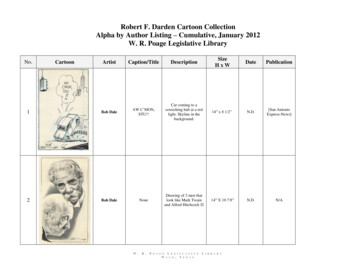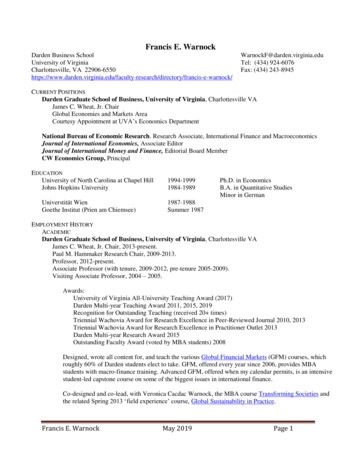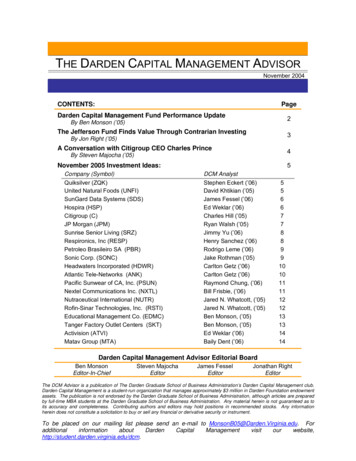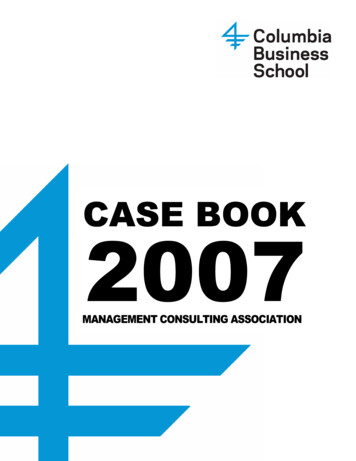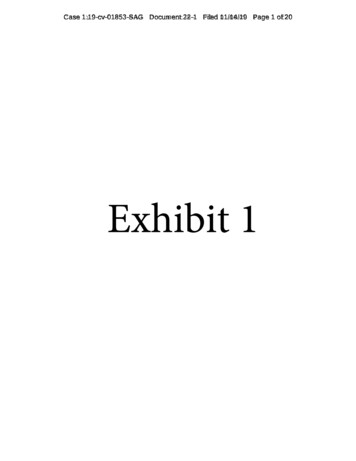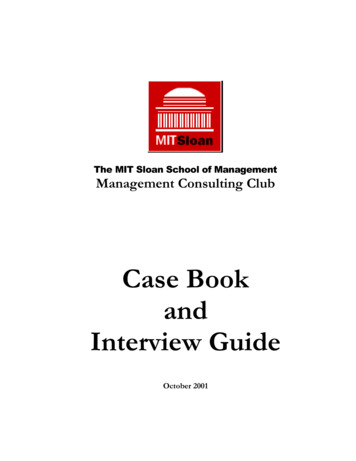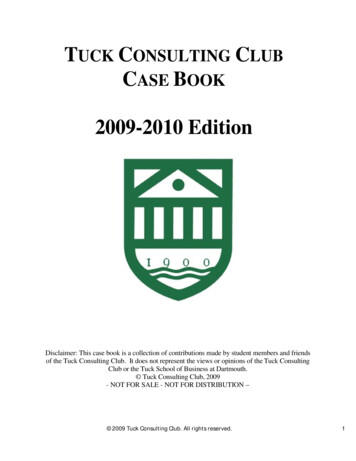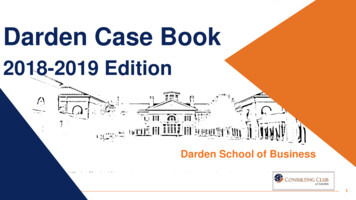
Transcription
Darden Case Book2018-2019 EditionDarden School of Business1
Darden Case Book 2018-2019 ForewordThe cases featured in the 2018-2019 Case Book are some ofDarden’s best cases from prior yearsNewMaterial 12 TotalCasesThis case book adds a new consulting industry guide, arevamped company profile page, and 12 total casesThe 2018-2019 Case Book features 6 brand new cases thatwill test a broad array of knowledge areas and math concepts6 NewCases5WritersThe 2018-2019 Darden Case Book has been made possible byDarren Constantine (MBA ‘19), Stephen Mortensen (MBA ‘19), PedroLemos (MBA ‘19) Seun Odekunle (MBA ‘19), & Caitlyn Unsworth(MBA’ 19)2
Darden Case Book 2018-2019 IndexCase Book TopicPagesConsulting Recruiting Schedule6Non-Verbal Tips for Success8What is a Case Interview?9Popular Case Themes10Case Interview Format11-22Industry Overview23-32Consulting Firm Overview33-43Case Book Guide45-46New 2019 Darden Cases48-113Updated Darden Cases114-1773*(N) Denotes new cases to the Darden case book (R) denotes refurbished cases
Darden Case Book 2018-2019 IndexCase TitleFirmIndustryRoundDifficultyQuant / Qual / OVR*PageNational Express Trucking(N)*Bain & Co.Transportation112148Styrofoam Situation(N)BCGFinancial / PE212158North-South Pharma(N)AT KearneyHealthcare122268Fire Proof Inc.(N)Parthenon EYManufacturing122283Quality Bottling Co.(N)Parthenon EYManufacturing123293Canyon Capital(N)Bain & Co.Financial / PE2323105Transportation Tech Co.(R)*Parthenon EYTransportation1222114Lonely Gas Station(R)BCGFinancial2312126Copier are1322147To Automate or Not(R)BCGRetail2233156Rubber Bumper Laboratories(R)McKinseyManufacturing1333167*(OVR) Denotes overall case difficulty*(N) Denotes new cases to the Darden case book (R) denotes refurbished cases4
Recruiting Schedule & Tipsfor Success5
Consulting Recruiting aryFebruarySecond Year Time-lineClub Intro &Recruiting Kick-offConsultingInterviewsClosed ListNetworking Sess.Q1Q2Winter BreakCompany Briefings & ApplicationSubmissionNetworking EventsFirst Year Time-lineCDC & ClubIntroductionsQ1Networking Events &SocialsClosed ListNetworking SessionsQ2Company BriefingsConsultingInterviewsWinter BreakQ3ApplicationSubmissionFirm Office Hours &Workshop SessionsFY Case Progression Tracker:No CasingTarget Case & Communication Score: (xx/25)Beginner12/25Intermediate18/25Proficient Master23/25Expert25/256*(Case score is based on the score sheet placed at the end of each case)
The Case Interview Process7
Non-Verbal Communication (Tips for Success)Communicating the correct message non-verbally is as important as the content that is communicated in a caseinterview. In order to recommend a candidate, interviewers must:1. Feel comfortable putting the candidate in front of a client2. Believe they would enjoy spending 60 hours a week with the candidate on a project teamYou Need to Convey Trustworthiness Confidence Competence Honesty Positivity Curiosity PassionHow to Develop These Traits Practice and gain proficiency in the technical requirements ofa case – free up mental energy to focus on connecting withthe interviewer Practice positive self-talk – the best way to demonstratethese traits is to truly believe you have them Practice quickly connecting with people about non-worksubjects – building rapport before diving into the interviewmakes an enormous difference (Note: Not always possible)8
What Is A Case Interview?A case interview is a simplified, condensed version of a complete consulting project. The candidate is in the driver’sseat and is expected to explore the data and provide solutions to an issue that a client paid the firm for.Ideal rsonal SkillsCultural Fit & PassionFrom Bain’s Website (but representative of all firms):The case interview is an example of a real business problem based on your interviewer's past work experiences. The problems you willencounter are not designed to be brainteasers, or theoretical problems designed to stump you, but rather to reflect the challengesthat our clients face. These real-life examples allow you to learn more about the type of work we do and the impact we have with ourclients.Bain looks for: The approach you take to solving a problem How analytical and creative your thinking is Your usage of data to quantify your recommendation(s) Your communication skills in conveying your ideas How you would suggest implementing those proposals"9
Consulting Case ThemesThe following case themes are the most popular topics tested and they are ranked in descending order of frequency.Please note that there are plenty more case topics than the 5 listed below.Profitability: Analyze potential sources of profit declines and identify ways to improveprofitabilityMarket Entry / Market Sizing: Analyze the client’s opportunity to expand and quantifythe viable market for any new productsGrowth: Identify opportunities for the client to optimally grow revenues or increasemarket shareAcquisition / Sale: Determine whether the client should purchase another business orsell an existing part of the companyIndustry Assessment: Assess the health and attractiveness of a particular industry toadvise a client’s decision10Note: This not an exhaustive list of all the types of cases you may experience
Case Interview FormatIntroFit QuestionCase InterviewQ&A3-5 Mins5 Mins20-30 Mins5 MinsPrompt &Clarifying Q.Prompt: This is the premise ofthe case. It will include somebackground on who the clientis and lay out the problem.Clarifying Questions: Somebasic contextual questions toguide your framework; not atime to get into the nitty grittyFrameworkFramework: Once you areconfident that youunderstand the prompt andcontext, you will take roughly90 seconds to lay out a"roadmap" for how toapproach the case. See thesection on "CaseFrameworks" for more tips.Exhibits &AnalysisExhibits: Provide importantinsights and next steps incracking a case. You shouldwalk through each exhibit withthe interviewer, confirmingunderstanding of its contentand identifying relevantpatterns or insights.Math: See the section on"Math" for more tips.BrainstormingBrainstorming: After theinitial analysis, theinterviewer will often ask youto brainstorm aroundadditional aspects of theproblem. See the section on"Brainstorming" for more tips.Conclusion/Next StepsConclusion: Recap (briefly!)the initial problem, presentthe logical conclusions andsolutions that arose fromanalysis and brainstorming(along with the data tosupport them.)Next Steps: Suggest some nextsteps for implementation orfurther research and point outany potential risks11Note: This format may differ by firm or by interviewer
Fit / Behavioral Question OverviewConsulting firms are assessing your ability to successfully work with teams and judge how well you understand theirfirm and yourself Tell MeAboutYourself WhyFirm X orConsulting Tell MeAbout ATimeWhen Your pitch should include: Where you have been / what you have done, who / where you are now, andwhat you are interested in going forwardAll answers must include: Relative skills & experiences, key transition points in your career, and a careerobjectiveStrong answers have: Powerful “hook” –your value proposition that highlights how you have thecompetencies they are recruiting forFirm & industry fit: Interviewee should have a deep understanding of a firm’s culture, functional expertise,and working styleIndustry interest: Interviewee should highlight experiences they want to gain and skills they can bringStrong answers have: This question answered in opening pitch, structured reasons why, and answerstailored to your prior experiences and future aspirationsExperience/ behavioral: Interviewee should demonstrate leadership ability, “drive” –taking initiative, andprofessionalismCAR: Context / challenge you faced, the action that you demonstrated, and the result of your actionsStrong answers have: Concise response, a learning element if the situation helped you grow, utilizesstructure, and engages the interviewer with energy, emotion, and authenticity12
The Prompt and Clarifying QuestionsPrompt & Clarifying Q.FrameworkThe Prompt All case prompts will introduce thecompany name, industry, and a briefdescription of what the client wants Some prompts tend to leave the primaryobjective to be vague Most prompts leave out the businesscontext of the clients core products oroperations in questionExhibits & AnalysisBrain-stormingConclusion/Next StepsClarifying Questions Clarifying questions should always behigh level (ex. Context on products, coregoal of the client, how client makesmoney) Don’t ask for detailed insights that youcan include in framework (ex. Details onprofitability drivers, market trends, etc ) Feel free to ask further clarifyingquestions as you are building framework13
The Case FrameworkPrompt & Clarifying Q.FrameworkExhibits & AnalysisBrain-stormingConclusion/Next StepsBy laying out a framework for analysis at the beginning of a case interview, you are not only keeping yourself organized,but you are providing a visual roadmap for the interviewer to see how you are thinking and where you are going.Characteristics of Great FrameworksIncorrect Framework Myths MECE: Mutually Exclusive, Collectively Exhaustive There is one perfect framework for every case Detailed but not lost in the weeds There is a finite number of possible frameworksthat will provide answers to every case Frameworks are not that important to the overallinterview Thorough but not wasteful Insightful but not presumptive14
Framework ExamplePrompt & Clarifying Q.FrameworkExhibits & AnalysisConclusion/Next StepsBrain-stormingSome frameworks are better than others to address a particular case. There are always multiple approaches that canyield the same answer.A simple framework example:Key Question in the PromptProfitability TreeMarket / ExternalCustomer / CompanyNotes ClarifyingAnswers CompetitorsEconomic HealthRegulation / GovernmentIndustry TrendsGeography / Climate Internal Capabilities Acquisitions Manufacturing Capacity Distribution NetworksBrand PerceptionExit StrategiesConsumer Preferences15
Other Framework ExamplesWhile being exposed to many frameworks can help build a strong repertoire of framework components, remember thatno amount of specific framework memorization will cover every possible case a candidate could encounter.Before & After Compare current with futureIdeal for a go/no-go decisionCan be used with profit tree (profits before andafter)BeforeEvaluation Criterion 1Evaluation Criterion 2Evaluation Criterion Company AM&A (similar to Before and After) Compare Company A, Company B, and CompanyA B along various meaningful criteriaAfterCompany BCompany A BEvaluation Criterion 1Evaluation Criterion 2Evaluation Criterion Option 1Option 2Option 3Option 4.Evaluation Criterion 1 -- Evaluation Criterion 2-.Alternative Evaluation Criteria Matrix) Alternatives listed across the topEvaluation criteria listed along the leftUse , -, o, or check marks to go through the listEvaluation Criteria.16For more details on Framework, please see appendix xx
Guide to Exhibits & AnalysisPrompt & Clarifying Q.FrameworkExhibits & AnalysisBrain-stormingConclusion/Next StepsRead The title of the exhibit to have aclear understanding of the informationObserve The legend and gauge thesizes of any bar graphs for insightsPay Attention To the footnotes for vitalinformation17
Guide to Math AnalysisPrompt & Clarifying Q.FrameworkExhibits & AnalysisBrain-stormingConclusion/Next StepsAlthough most case mathematics will involve simple arithmetic, it is still very easy to make mistakes. Follow the tipsbelow to ensure that you are set up for success.Tips for SuccessSanity CheckMistakes are OKUse ShortcutsMake sure yournumbers makesense in the contextof the caseYou can recoverfrom mistakes, justdon’t make thesame mistake twiceRound whenneeded andmanage your zero’sappropriatelyTalk it ThroughExplain each stepthat you are doingwith yourinterviewerSo WhatTie the numbersback to thequestion andexplain theimplicationsPracticepractice until you’recomfortable doingmath in front of aninterviewer18
Guide to Math AnalysisPrompt & Clarifying Q.FrameworkExhibits & AnalysisBrain-stormingConclusion/Next StepsTricky Math ExamplesPayback PeriodNet Present ValueBreak-even SalesA.Calculates the discounted return oninvestment over timeA.Calculates the amount of time requiredto pay back an upfront investmentA.Calculates the number of units sold topay back an upfront investmentB.Requires cash flows (revenues - costsover a time period), discount rate,timeframe, and an upfront costB.Requires cash flows per period and anupfront costB.Requires per-unit selling price, per-unitcosts, and upfront investment costC.Payback period will be extremely long,extremely short, or you will be givensome type of specific criterion theclient uses (e.g. 5 years)C.Break-Even Sales Upfront InvestmentCost/(Per-Unit Selling Price - Per-UnitCosts)C.Some cases will assume a calculationinto perpetuity (timeframe forever).D. Perpetuity: (Cash Flow per Period /Discount Rate) - Upfront CostD. Payback Period Upfront Cost / CashFlows per Period19
Guide to Math Analysis (Things to Take Note)Prompt & Clarifying Q.FrameworkExhibits & AnalysisBrain-stormingConclusion/Next StepsExample ScenarioHow much money will the client save?CurrentState Mater. /Unit# Labor /UnitVolumeTotalCostProduct 115101M 25MProduct 25202M 50M 75M10% Labor Reduction on a per unit basisFutureState Mater. /Unit# Labor /UnitVolumeTotalCostProduct 11591M 24MProduct 25182M 46M 70MA. Structure is crucial. The more you can structure informationlike an Excel Spreadsheet, the betterI.Helps you recover informationII. Your interviewer can follow alongIII. It makes you look organizedB. Write down prompts such
The case interview is an example of a real business problem based on your interviewer's past work experiences. The problems you will encounter are not designed to be brainteasers, or theoretical problems designed to stump you, but rather to reflect the challenges that our clients face. These real-life examples allow you to learn more about the .
